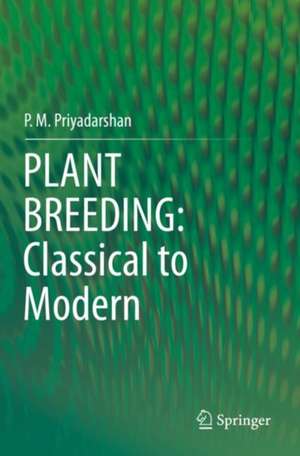PLANT BREEDING: Classical to Modern
Autor P. M. Priyadarshanen Limba Engleză Paperback – 20 noi 2020
The book’s content addresses the needs of students worldwide. Modern methods like molecular breeding and genomics are dealt with extensively so as to provide a firm foundation and equip readers to read further advanced books. Each chapter discusses the respective subject as comprehensively as possible, and includes a section on further reading at the end. Info-boxes highlight the latest advances, and care has been taken to include nearly all topics required under the curricula of MS programs. As such, the book provides a much-needed reference guide for MS students around the globe.
| Toate formatele și edițiile | Preț | Express |
|---|---|---|
| Paperback (1) | 472.83 lei 38-44 zile | |
| Springer Nature Singapore – 20 noi 2020 | 472.83 lei 38-44 zile | |
| Hardback (1) | 608.01 lei 38-44 zile | |
| Springer Nature Singapore – 20 noi 2019 | 608.01 lei 38-44 zile |
Preț: 472.83 lei
Preț vechi: 583.74 lei
-19% Nou
Puncte Express: 709
Preț estimativ în valută:
90.49€ • 94.12$ • 74.70£
90.49€ • 94.12$ • 74.70£
Carte tipărită la comandă
Livrare economică 10-16 aprilie
Preluare comenzi: 021 569.72.76
Specificații
ISBN-13: 9789811370977
ISBN-10: 9811370974
Pagini: 570
Ilustrații: XXIII, 570 p. 208 illus., 124 illus. in color.
Dimensiuni: 155 x 235 mm
Ediția:1st ed. 2019
Editura: Springer Nature Singapore
Colecția Springer
Locul publicării:Singapore, Singapore
ISBN-10: 9811370974
Pagini: 570
Ilustrații: XXIII, 570 p. 208 illus., 124 illus. in color.
Dimensiuni: 155 x 235 mm
Ediția:1st ed. 2019
Editura: Springer Nature Singapore
Colecția Springer
Locul publicării:Singapore, Singapore
Cuprins
Part I. General Topics.- 1. Introduction.- 2. Objectives, Activities and Centres of Origin.- 3. Plant Introduction.- Part II. Developmental Aspects.- 4. Mode of Reproduction and Breeding Systems in Plants.- 5. Incompatibility.- 6. Sterility.- 7. Biometrics and Informatics.- Part III. Breeding Methods.- 8. Selection.- 9. Backcross Method of Selection.- 10. Hybridization.- 11. Breeding Self-pollinated Crops.- 12. Breeding Cross-Pollinated Crops.- 13. Inbred Line Development.- 14. Population Improvement.- Part IV. Specialized Breeding.- 15. Heterosis.- 16. Hybrids and Synthetic Cultivars.- 17. Induced Mutations and Polyploidy Breeding.- 18. Distant Hybridization.- 19. Quality Breeding.- 20. Ideotype Breeding and Multi-trait Selection.- 21. Host Plant Resistance Breeding.- 22. Breeding for Stress Adaptation.- 23. Genotype-By-Environment Interactions.- Part V. Plant Biotechnology.- 24. Tissue Culture.- 25. Genetic Engineering.- 26. Molecular Breeding.- 27. Genomics in Plant Breeding.- Part VI Intellectual Property Management.- 28. Intellectual Property Management
Notă biografică
Dr Priyadarshan is a prominent Hevea rubber breeder. He began his research career by breeding triticale and wheat. During the 1980s he focused on the in vitro culture of spices. He joined the Rubber Research Institute of India (Rubber Board, Ministry of Commerce, Govt. of India) as a Plant Breeder in 1990 and specialized in breeding Hevea rubber for sub-optimal environments. In 2009, he became the Institute’s Deputy Director, and managed its Central Experiment Station until 2016. As a scientist, he has been involved in breeding cereals, spices and Hevea rubber for the past 32 years. During that time, he has published several research papers and chapters in journals and books of international repute. He has authored articles for several important journals, e.g. Advances in Agronomy, Advances in Genetics, and Plant Breeding Reviews, and has edited books on Breeding Plantation Tree Crops, Breeding Major Food Staples, and the Genomicsof Tree Crops, as well as a book on the biology of Hevea rubber.
Textul de pe ultima copertă
This book offers a detailed overview of both conventional and modern approaches to plant breeding. In 25 chapters, it explores various aspects of conventional and modern means of plant breeding, including: history, objective, activities, centres of origin, plant introduction, reproduction, incompatibility, sterility, biometrics, selection, hybridization, methods of breeding both self- and cross- pollinated crops, heterosis, synthetic varieties, induced mutations and polyploidy, distant hybridization, quality breeding, ideotype breeding, resistance breeding, breeding for stress resistance, G x E interactions, tissue culture, genetic engineering, molecular breeding, genomics, gene action and varietal release.
The book’s content addresses the needs of students worldwide. Modern methods like molecular breeding and genomics are dealt with extensively so as to provide a firm foundation and equip readers to read further advanced books.
Each chapter discussesthe respective subject as comprehensively as possible, and includes a section on further reading at the end. Info-boxes highlight the latest advances, and care has been taken to include nearly all topics required under the curricula of MS programs. As such, the book provides a much-needed reference guide for MS students around the globe.
The book’s content addresses the needs of students worldwide. Modern methods like molecular breeding and genomics are dealt with extensively so as to provide a firm foundation and equip readers to read further advanced books.
Each chapter discussesthe respective subject as comprehensively as possible, and includes a section on further reading at the end. Info-boxes highlight the latest advances, and care has been taken to include nearly all topics required under the curricula of MS programs. As such, the book provides a much-needed reference guide for MS students around the globe.
Caracteristici
Provides a detailed overview of conventional and modern approaches to plant breeding Addresses all the topics required for the curriculum of undergraduate and master’s students Covering plant breeding, biotechnology and molecular components, it offers a package of breeding and appropriate molecular techniques
